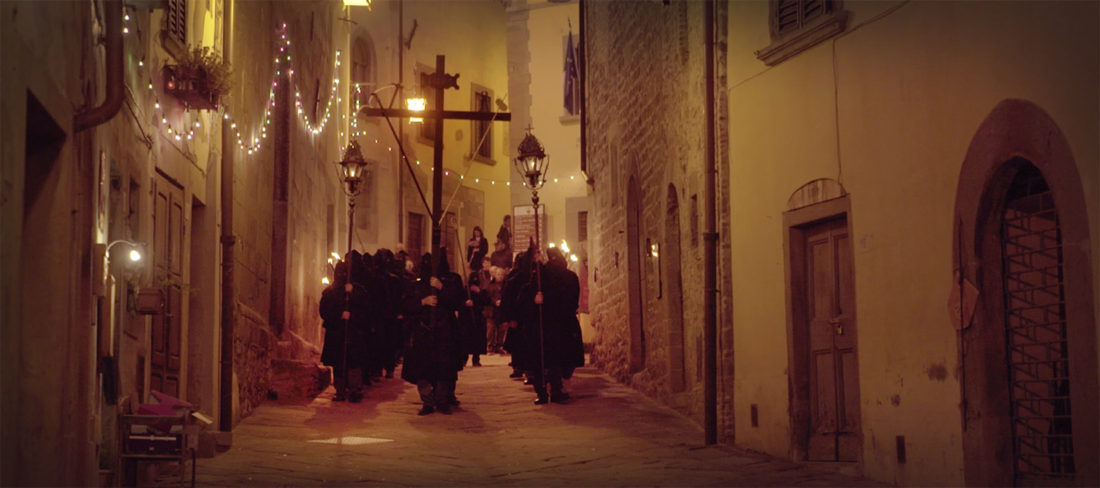
The world of Italian brotherhoods
The Misericordia procession on the night of Good Friday is mysterious and evocative, and to an American sensibility, alarming. A procession of hooded and robed figures carrying crosses and a symbolic coffin, lit by torchlight, followed by hundreds of villagers is a glimpse into another world. It is one of those moments when I need to put my cultural instincts on hold to understand what is really going on in my little corner of Italy. I was watching the procession when one of the figures, unrecognizable in his hood, paused to say hello and I recognized the voice of a friend. I called him later to invite him to meet for coffee so that I could learn more.
The robed members of the procession were members of the Misericordia, an ancient cofraternity, or brotherhood, present in nearly every town in Italy. Today, the Misericordia provides ambulances and emergency staff, volunteers to drive the elderly to doctors appointments and physical therapy, and during Donella’s year in middle school it was the Misericordia who drove a fellow student, who was quadriplegic, to and from school every day in a special van. But I was unclear on how this civic function related to the procession.
The idea of laymen banding together in such brotherhoods is a very ancient tradition, first happening in Constantinople and Alexandria. The first one in Europe popped up in Paris in 1208. Cofraternities arose during the middle ages when these groups of “brother citizens” filled gaps that existed because there was no functioning government, only a feudal system caught between the power of rich landlords and the church. Somehow people needed to get buried, especially during times of plague, the sick needed to be tended, orphans and illegitimate children needed care (and dowries!), and prisoners needed a companion to take them to execution. Another friend (who is not a member) mentioned that these brotherhoods often aided members in deeper business and social ties with bits of friendly information and advantages, in addition to fulfilling one’s duties as a “good Christian”.
Although there were a range of these organizations, the main one that exists in modern times is the Misericordia. Our village organization dates from 1348, the year the plague hit. (Once was not enough in 25 years as the plague also returned in 1363 and 1374.) The group had a few struggles in the 1700s when the Grand Duke Leopold thought these brotherhoods had too much power and disbanded them, but they returned as nothing nearly as effective replaced them.
My friend from the procession, who is a member, said that he is the third generation of his family to belong and that supporting the group is an important tradition, especially as membership has declined by about 50% over the last forty or so years. The Misericordia is deeply rooted in the Church, but not run by the Church, and it was impossible for my friend to weigh whether belonging had a more religious or secular/service meaning. “As with much in Italy, it is largely the same.” People in the village are expected to support the group by contributing what they can in time, money, or both. Some of the staff is highly trained and receive salaries to work full-time as EMTs, but there are many ways to be involved, such as volunteering to drive those who can’t to appointments.
I was describing the difference between calling “911” in America, where an ambulance appears that you will have to pay for, staffed by people you’ve never met, with our experience once in calling “118” here where five paramedics appeared with an ambulance which took us to the hospital, all free of charge, and my friend was surprised. I said that we have no equivalent (or tradition) of the Misericordia because we don’t have the same sense that seems to pervade the Italian village that we all need to take care of each other. He looked puzzled as he tried to imagine this lack of ties to the people who live around you.






Mark Hinshaw
March 16, 2024 at 2:16 pmThanks for the fascinating backstory on this marvelous and generous tradition. In our small village, this group of volunteers — from mid 20s to mid 70s in age — are always present, ready to help if needed. Their orange jumpsuits with reflective tape and the colorful, sparkling-clean vehicles contrast with the ancient buildings. They also help sponsor and staff community events, with an ambulance and stretcher prepared in case someone has a problem. They have a small fleet of trucks and buses that serve the seven hilltowns in the vicinity. Their highly visible prominence gives me the sense that we are being cared for everyday with expert service — without worrying about how much it might cost.
Nancy
March 16, 2024 at 6:09 pmThanks for writing! I love how efficient and caring they are as well.
Nancy
Cary Tennis
March 10, 2021 at 10:21 amBeautiful. Thank you. I was about to try to explain the Misericordia to someone and … this does it beautifully. ciao–Cary T.
Nancy
March 13, 2021 at 9:22 amthank you so much! It’s a bit of a hard one to describe!